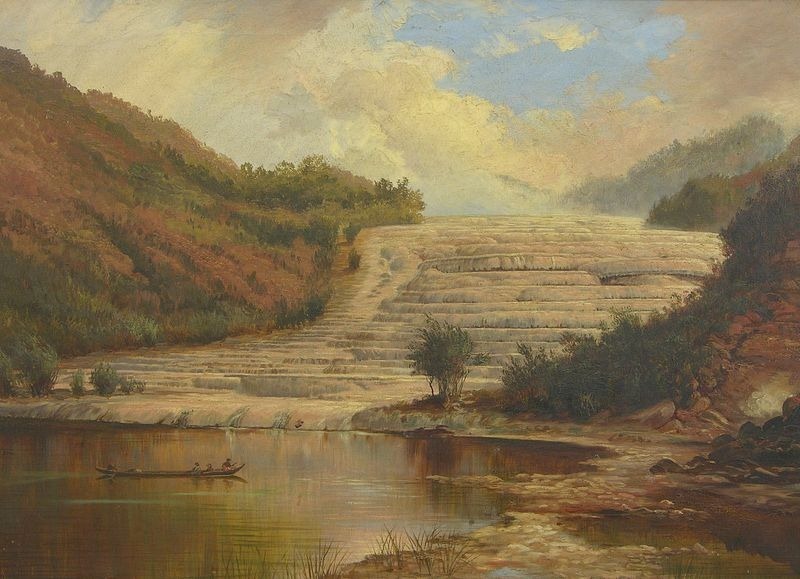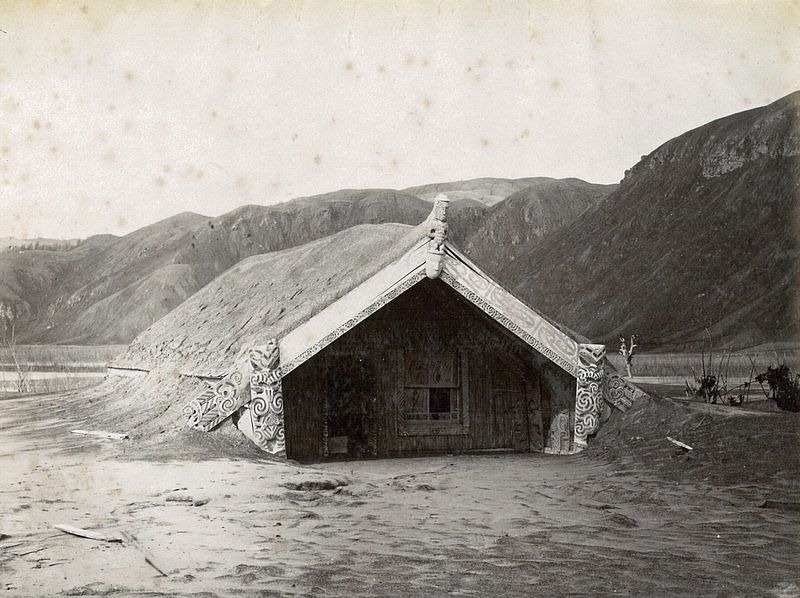In the Rotorua district, in northern New Zealand, about 25 kilometers to the east of the city of Rotorua, were two small lakes known to the local Maori people as Rotomakariri (Cold Lake) and Rotomahana (Warm Lake). The shores of Rotomahana were adorned by one of the most spectacular travertine terraces — the largest in the world — created by the deposition of minerals from the nearby hot water springs. So wonderful were these terraces that they were called the ‘eighth wonder of the natural world’ and were New Zealand's most famous tourist attraction until the end of the 19th century. Then Mount Tarawera erupted and destroyed this natural wonder forever.
The Pink Terrace with the White Terrace in the background, a painting by John Barr Clarke (1835-1913). Photo credit
There were two terraces — the larger White Terraces, known by Maori as Te Tarata (the tattooed rock) and the smaller Pink Terraces, locally known as Otukapuarangi (fountain of the clouded sky). The White Terraces were at the north end of Lake Rotomahana and faced away from the lake. They covered 3 hectares and descended over approximately 50 steps to the lake’s edge 40 meters below. The extra sunlight they received from facing north gave them a more bleached or white appearance.
The Pink Terraces were about 800 meters away or two thirds of the way down the lake sheltered from the harsh sun on the western shores, facing south-east. Their pink appearance was largely due to less sunlight reaching them and therefore less bleaching. It’s where people went to bathe on the lower levels because the temperature of the water was lukewarm. The Pink Terraces descended 30 meters over a distance of 75 meters.
Both terraces were fed by water regularly spouting from two geysers located above Lake Rotomahana and cascading down the hill slope. The waters had dissolved minerals that crystallized over hundreds of years to form these brilliant stepped structures.
Charles Bloomfield's oil on canvas painting of the White Terraces. Dated 1893. Photo credit
When visiting missionaries and European traders saw the Pink and White Terraces, they were stunned by its size and appearance. Word spread and soon wealthy tourists from as far as England and Canada began making the long trip to see these magnificent natural structures for themselves. New Zealand was still relatively inaccessible at that time and passage took several months by ship. This was followed by an overland trip of 150 kilometers on a coach, a 15-mile hike through the bush, a 7-mile boat ride across Lake Tarawera, and finally a canoe ride on Lake Rotomahana.
The Pink and White Terraces became New Zealand's most famous tourist attraction. The Maori villagers living nearby set up a burgeoning tourist trade by providing canoe and acting as guides and boatmen. They also ran a small hotel nearby and entertained visitors with dancing and singing.
All this changed during the night of 10 June 1886 when Mount Tarawera erupted. The massive explosion ripped through the center of Lake Rotomahana and hurled tons of lakefloor sediment for miles around covering everything around with meters thick mud. Along with the terraces, it destroyed several villages and killed nearly 150 people. After the eruption, a crater over 100 meters deep formed on the site of the terraces. This filled with water to form a new Lake Rotomahana, 30 meters higher and much larger than the old lake.
The terraces were originally thought to have been completely destroyed, but as later research revealed, part of it had survived and was simply buried under a thick layer of mud about 50 meters under the current lake surface. Recovery is impossible unless someone decides to drain Lake Rotomahana which isn’t going to happen, so its unlikely that anyone is ever going to see the terraces again.
Lake Rotomahana is still very isolated, and aside from the occasional team of researchers still probing for the lost terraces, it sees little tourism.

Charles Bloomfield's oil on canvas painting of the Pink Terraces. Dated 1893. Photo credit
Charles Bloomfield's oil on canvas painting of the Pink Terraces. Dated 1886. Photo credit
Images from the 1873 book The Wonderland of the Antipodes and other sketches of travel in the North Island of New Zealand by J Ernest Tinne. Photo credit
Images from the 1873 book The Wonderland of the Antipodes and other sketches of travel in the North Island of New Zealand by J Ernest Tinne. Photo credit
Images from the 1873 book The Wonderland of the Antipodes and other sketches of travel in the North Island of New Zealand by J Ernest Tinne. Photo credit
Images from the 1873 book The Wonderland of the Antipodes and other sketches of travel in the North Island of New Zealand by J Ernest Tinne. Photo credit
Images from the 1873 book The Wonderland of the Antipodes and other sketches of travel in the North Island of New Zealand by J Ernest Tinne. Photo credit
After the eruption of Mount Tarawera. Photo credit
After the eruption of Mount Tarawera. Photo credit

After the eruption of Mount Tarawera. Photo credit
Lake Rotomahana today. Photo credit
Steaming cliffs on the shore of Lake Rotomahana. Photo credit
The Frying Pan Lake, the largest hot spring in the world, is located in Waimangu Volcanic Valley created on 10 June 1886 by the volcanic eruption of Mount Tarawera. Photo credit
Sources: Wikipedia / NewZealand.com / Woods Hole Oceanographic Institution




























I miss the 1800s as well.
ReplyDelete